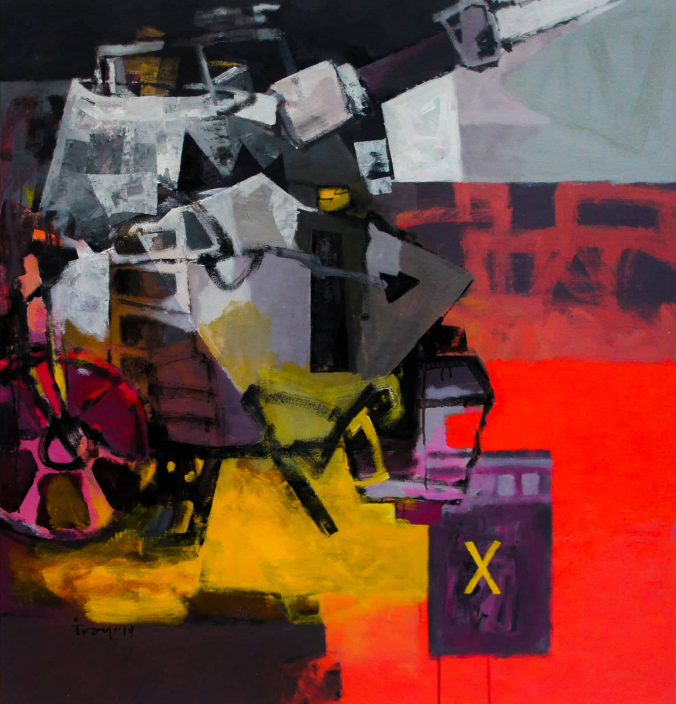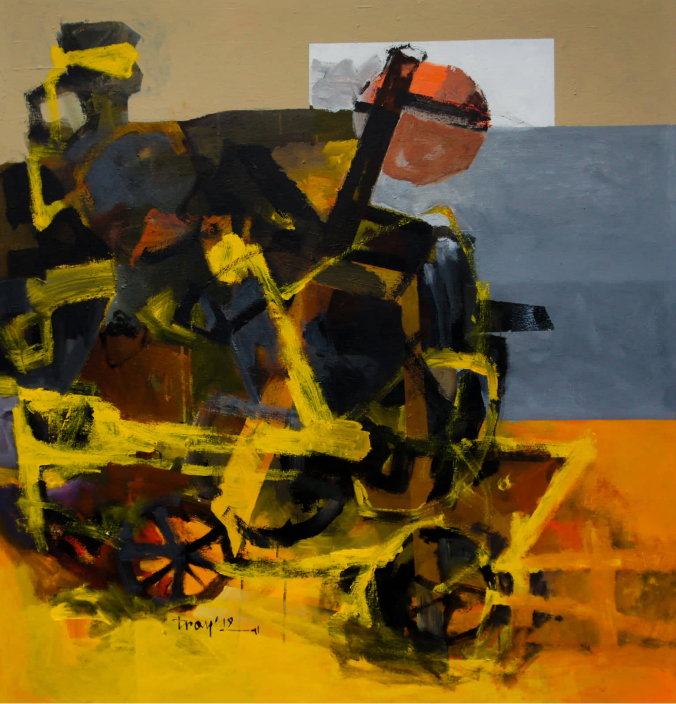I was born in the Sundarban Delta region of Bangladesh in the year of 1971. It was during the time of war, genocide and ethnic cleansing by the authoritarian army of Pakistan along with local religious radicals. Millions of the minority Hindu community were butchered and several other millions were driven out of their indexs. Like thousands of other families, my family also fled to India in a small wooden fishing boat. It's an area that consists of several rivers and their tributaries networked like veins and capillaries and naturally many families took the water routes to find safe places and save their lives. Roads were unsafe as there was fierce fighting in the land and all escape routes were blocked with tanks and machine guns. The waters became red and my family had to pass through floating mutilated bodies amidst mayhem and fear. At the year-end, after a gory battle, the Eastern part of Bengal got freedom and a new country, Bangladesh was born. It was during my family's journey back index I was born.
Since unborn and being in my mother's womb, I witnessed the shadow and horror of war in the form of sound (whirring warplanes, guns, etc.), visuals through narratives and later on visuals through photography and other media. I still wake up at midnight from nightmares of dragon bomber planes whirring and flying like monsters. Later on when I was grown up enough, I witnessed blood thirst, hatred in the eyes of people. The war was over, but it took several years for lives to recover from famine and numerous other side effects, engraving aside an everlasting impression in human minds and souls.
My childhood was tough, yet it's beautiful as I recall the sweet and sour days. I was in school and enjoying the sweet corn doughs given as mid-day meals courtesy the UNESCO. Attending classes in school with a six km walk through mud and water was rather fun. In the rainy seasons, while going to school, we had to carry an extra set of clothes as we had to cross small channels of water and knee height muds. It was fun having new friends in school, playing soccer in the interval, walking through the paddy fields, getting drenched in the rain on the way to or from school, chattering in between classes and getting canned at times for showing indiscipline, etc. These are the memories of the sweet and sour butterfly days. Though it was a difficult time in terms of the economy and prosperity of a society or a country, it was the best time like any other kids to be grown up under the parents’ wings and care.
The journey as an individual started just after childhood. The quest to learn helped. After graduation I got admitted into an institute to learn Art.
But tremendous family pressure to get a job made me stop my education abruptly. It was difficult for me to get into a job, perhaps I wanted to be something else. I had to leave my ancestral place to discover the unseen. I spent some years in Kolkata in the 80's. In Kolkata the real seeds of art sprouted in me and I enjoyed creating all the things in the realm of Realism. My Kolkata days were beautiful and full of dreams. Many humanly aspects that grow and flourish in life like the cherry blossoms happened in Kolkata.
In the late 80's I set for Delhi. It was a rather melancholic time that stretched for years. I could never be a regular family man and had to go through a bad marriage that lasted for nine years. I had to choose odd freelance jobs, giving private tuition to young students or teaching them art, etc. But Delhi gave me wings to be an Artist. I started getting deeper into Art while in Delhi as I entered into the realm of Abstraction. Perhaps it was the time I started realising the myriad facets of life underneath the visible periphery.
I always gave my best to one thing at a time. It means that I was and am very bad at multitasking. While one aspect in life was addressed, the others were ebbing. My little earnings could hardly save a family. It was painful days after my little son had to say goodbye to me with tearful eyes. I was deprived of legal help to exercise the right to get in touch regularly with my son who gradually became my best friend. I got into a depression that lasted for years, yet it was art that gave me new dimensions and dreams to do what I really wanted to as a human. Books, music and nature healed and gave strength. Social issues like untouchability, casteism, exploitation of the people of lower caste and strata, religion based hatred and genocides, war, etc. are the issues I focused on to address through my art as these things gave me eternal pain.
Various issues in societies and around the world, particularly in the South Asian context crippled me and I seriously needed a language to express myself, my concern, my ecstasy, my anger etc. It is Art. It's absolutely disturbing to see superstitions, bigotry over religious practices, discriminatory social customs, etc. still prevalent where values and dignity of life is bulldozed by hunger for power and pride.
It's the same South Asia where renaissance happened 200 years back and many discriminatory social systems like Satidaha
(Satidaha : A Brahminical custom where a widower was burnt alive along with the dead body of her husband. 'Sati' means a 'pure' girl, 'Daha' means 'to burn'. The logic was that after the death of a woman's husband, all her physical desires had to be submitted to the almighty, so she had to die. Also the women were made to believe that the husbands were their Gods. More horrible was the practice that young underaged girls were made to marry old Brahmin men and given dowry to restore honour to the family of the non Brahmin girls. Consequently when the old men used to die because of old age, the young widows were to sit on the funeral pyre to be burnt alive alongside their dead husbands), No Widow Marriage (Vidarbha bibaha : Where a widower could never marry again and had to live with austerity wearing a white piece of cloth for the rest of the life.) were abolished. It's the same South Asia that created countless wise men, Musicians, Poets, Thinkers, Philosophers, Mathematicians, Scientists, Great Sufi Saints etc. who brought accolades from the entire world and showed road maps towards a prosperous humanity that is suffering a bleeding wound at the present time.
History repeats. Sometimes it repeats the glorious past, sometimes it brings back the wicked darkness that once had shamed the world. That's exactly what is happening in a part of Asia where people are incited to be frenzy and violent in the name of patriotism and religion. It's the kind of conspired web of hyper-nationalism that the world had observed in Adolf Hitler's Germany. The horror of Auschwitz, Hiroshima and Nagasaki flashes back. It's South Asia where people are stoned to death today, or young couples are lynched to die because their marriage is forbidden as they belong to different castes or religions. Studying and getting deeper into history burdens humans with a sense of responsibility. Perhaps I'm bearing those burdens happily amidst times of tribulations. Perhaps creating something aesthetically appealing to the people is joyful and at the same time easy to meet necessities of day to day life, but where is aesthetics in war and hunger? Maybe the eternal quest that haunts me is why people have to be so cruel and dominant to destroy others as well as the beautiful earth?
I preferred to be a bohemian traveling through the Hills, Rivers, etc. and meeting people of various ends. Expressions in the eyes of people, of sadness or happiness, makes me curious about life. Besides, I find people with different cultures, origins, dialects, and way of living appealling and absorbing. Nature attracts me in mysterious ways. The smell of flora and fauna drives me to a different world. It gives me a feeling of eternal bond or togetherness from an infinite past. I have the craving to trek alone in the bushes or woods only to get lost in it. Perhaps that's because I grew up beside the Sundarbans (A mangrove forest). Name gives me tremendous energy to study, paint and write. I pick forms and colors from nature. The ever changing colours of the mountains, the floating clouds, roaring mountain rivers or saintly silent rivers of the plains- they bless me with stories untold of the human race, of animals, of the birds, they bless me with songs unheard. Hence I'm into the lap of nature. I got inspiration from Artists like Alberto Burri, Antonie Tapies, Franz Kline. My works are rather monologues that cry for reaching people to create silent dialogues.
1971年,我出生在孟加拉共合國的蘇達班三角洲(Sundarban Delta)一帶。那是一個巴基斯坦獨裁軍隊及地方宗教激進份子展開戰爭、大屠殺和種族清洗的年代。數百萬的印度教少數族群遭到殺害,還有數百萬人被迫逃離家園。我的家人和其他數以千計的家庭一樣,也搭上小型木造漁船逃離印度。這個地區有著數條河流及其支流所形成網絡,像大大小小血管一般,因此很自然地,許多家庭選擇依水路逃到安全之地,以求保命。相較之下,陸路則不安全,因為沿路仍有激烈戰事,所有逃生路線都被坦克和機關槍所封鎖。河水被血液染紅,我的家人也必須在飄浮的殘屍之間,在混亂及恐懼中逃難。那年底,在歷經一場令人髮指的戰事後,孟加拉東部獲得自由而成為新的國家,孟加拉共合國這個新國家誕生,而我就是在家人返鄉的旅程中出生的。
打從我尚未出生、仍在母親的子宮裡時,就已經藉由聲音的形式(轟隆隆的戰機、機槍等)和敘事裡的視覺,見證了戰爭的陰影及可怕,爾後則是透過攝影的視覺影像及其他媒體。至今我仍會在午夜夢迴時,因為夢中猶如怪物的龍式轟炸機的轟隆聲而驚醒。後來隨著年紀漸長,我也見識到嗜血殺戮及人們眼中的仇恨。戰爭雖然結束了,但要經過數年,人們的生命才得以從飢荒和各種戰爭的副作用中復原,而這些也都深深刻入所有人的心中和靈魂,成為永久的印記。
我的童年雖然艱困,但在想起那些酸甜往事時,也依舊美好。在學時,我會吃著「聯合國教科文組織」(The United Nations Educational, Scientific and Cultural Organization, UNESCO)所提供的甜玉米麵團當作中餐。而步行六公里、走過有著泥沼和水漥的上課路程其實趣味十足。雨季時,上學必須多帶一套衣物,因為我們必須跨越小溪流和及膝的泥坑。在學校交到新朋友、下課時踢足球、步行穿越稻田、上學和返家途中被大雨淋的一身溼、課堂休息時間的閒聊,和因為不聽話而被趕出課堂等都很有趣,成了那段酸甜美好時光的回憶。雖然就社會或國家的經濟及繁榮來說,那是一段很辛苦的日子,但對於在父母羽翼和照顧下成長的所有孩童來說,那是最棒的時光。
童年結束後,個人的歷程就此展開。對學習的追求在此產生助益。畢業後,我進入學院學習藝術,但因為來自家人要我開始工作的巨大壓力,我被迫中止學業。然而,找工作對我來說實在不容易,也許是因為我想做別的事。我必須離開家族世代所居之地,追尋那肉眼不可見的東西。80年代,我在加爾各達(Kolkata)住了幾年。在那裡,真實的藝術種子開始在我內心萌芽,我享受在寫實的國度中創作各種事物。那段在加爾各達的日子既美妙又充滿夢想;生命中許多成長、茁壯的人性面向,彷彿櫻花綻放一般,都發生在加爾各達。
我在80年代後期去了德里。那是一段長達多年又特別憂鬱的時光:我一直無法當個一般戀家的男人,最後只能結束一段為期九年的糟糕婚姻。我當時也必須接一些奇怪的工作案件,並替年輕學生開授藝術家教課程。不過德里給了我成為藝術家的翅膀。在德里時,隨著我探入抽象的國度,我也開始進入更深層的藝術。也許就是在這段日子中,我開始在那可見的邊緣之下,實踐生命中的種種面貌。
我一直專心一致的一次做一件事,也就是說,我從以前到現在都很難一心多用。當我處理生活中的某個面向,對其他面向的注意力就會消退。我微薄的薪水難以養活一個家庭。在我的小兒子淚眼汪汪的向我告別後,日子真的很難熬。當時我沒有任何法律協助教我行使權利,讓我能定期跟兒子見面,但後來他仍成為我最好的朋友。有好幾年,我罹患了憂鬱症,是藝術讓我看到新的層面和夢想,讓我活得像人一樣能做自己真的想做的事。書籍、音樂和大自然療癒了我,給我力量。諸多社會議題如:賤民、種性主義、剝削低種姓和低階層人民、建立在仇恨和屠殺之上的宗教、戰爭等等,都是我透過藝術所探討的議題,因為這些在我心中留下了永恆的傷痛。
全世界各個社會中,特別是在南亞的脈絡下的諸多議題,都讓我難以忍受,我必須要以某種語言來表達自我、我的顧慮、欣喜和憤怒等等——這種語言就是藝術。每當我看到迷信的、偏執的宗教行徑、歧視性的社會風俗等等,我就感到極度不舒服,這些事情仍在許多地方上演,在那裡生命價值及尊嚴被對權力和驕傲的渴望所欺凌。
在二百年前曾經見證文藝復興的南亞也一樣,不過許多歧視性的社會系統,如「娑提妲哈」(Satidaha;「娑提妲哈」是一種婆羅門習俗,規定寡婦必須活生生地與過世先生的遺體一同火葬。「Sati」意思是「純潔」的女性,而「Daha」則是「焚燒」之意。這項習俗背後的邏輯是婦女在丈夫死後,其所有肉體慾望也歸於上天,故她必須以自焚殉夫。同時,婦女們也被灌輸丈夫即為其神祉的觀念。更可怕的是,年輕未成年的女孩會被迫嫁給年長的婆羅門男性,而其家庭會獲得足以回復其家庭榮耀的嫁妝。因此,當年長丈夫年老過世後,年輕的寡婦就必須坐在火葬堆上一同自焚殉葬)和「寡婦不得改嫁」(Vidarbha bibaha;這個習俗要求寡婦一輩子不得再嫁,必須一生身著白衣並過著禁慾的生活)等習俗已遭廢止。也是在同樣的南亞出現了無數的智者、音樂家、詩人、思想家、哲學家、數學家、科學家、偉大的蘇菲聖者等等,他們為全世界帶來許多榮耀,也為當前受傷流血的人性指引了邁向繁盛的道路。
歷史不停重演;有時重覆過往的榮光,有時也帶回那曾經讓世人羞愧的邪惡黑暗。這也正是一部份的亞洲人民正在經歷的:他們受到以愛國主義及宗教為名的煽動,陷入顛狂、暴力之中。也正是這張極端民族主義的共謀之網,讓全世界看到希特勒在德國的崛起,而奧許維茲的恐怖、廣島及長崎的歷史也閃過眼前。至今在南亞,仍有人被施以石刑至死,也有年輕情侶遭受私刑殺害,只因為他們的婚姻是不同階級或宗教的結合而被禁止。深入研究人類歷史會帶來一種責任感,也許我樂意在這種苦難的時代,肩負這樣的沉重負擔;也許創造出對人們來說具有美感的東西能帶來喜悅,同時又能滿足日常生活所需。但是,戰爭和飢餓的美學在哪兒呢?也許纏繞在我心頭的永恆追尋,正是人們為何會如此殘酷又想支配一切,而不惜催毀他人和這個美麗的地球?
我偏愛波西米亞式的生活,旅行在山河之間,與有著不同旅行目的的人相遇。人們眼中傳達的訊息,無論憂傷或欣喜,都讓我對生命感到好奇。此外,我也覺得有著不同文化、根源、方言和生活方式的人們是動人又有趣的。此外,大自然以神秘的方式吸引著我,花草的味道帶我到不同的世界,讓我感覺到一種永恆的連結,或是與無盡的過去成為一體。我渴望在草木森林中獨自漫步直到迷失其中,也許這與我在蘇達班(紅樹林森林)的成長經驗有關。名字也賦予我強大的能量,讓我能夠研究、繪畫和書寫。我從自然中挑選形態和顏色,而山林、浮雲、轟鳴作響的山中湍流或聖潔寧靜的平原河川,都賜予我有關人類、動物、鳥類的未知故事,以及從未聽聞的歌曲。因此,我投入自然的懷抱,也從阿爾貝托.伯里(Alberto Burri, 1915-1995)、安東尼.塔皮埃斯(Antonie Tapies, 1923-2012)和弗朗茲.克萊恩(Franz Kline, 1910-1962)的作品中汲取靈感。我的作品就如同渴望接觸人們的獨白,構築起寂靜的對話。





